Trademark Application FAQs
Detailed Information About U.S. Trademark Rules, What to Expect & More
Want to learn more about our firm and why we’re the best choice for your U.S. trademark application?
Not ready for these technical FAQs? Check out our simple process guide to get an intro to our work.
FAQs for Trademark Clients
If you’re an Amazon seller, click here to read the FAQs for our Amazon Brand Registry services.
+ FAQ #1: What are the benefits of filing a trademark application?
Having a unique and recognizable brand is essential to your success as a business. You have “common law” (unregistered) trademark protection from the moment you start using your brand to sell products or services in the U.S., but seeking federal trademark protection at the U.S. Patent and Trademark Office (USPTO) offers many additional benefits:
Nationwide priority: Common law trademark rights are limited to the small, geographic area where you are selling your products or services. When you go to expand to other markets, you might find your trademark is already taken! A federal trademark registration gives you presumptive use, priority, and validity nationwide, so you can grow your business knowing your trademark is secure.
Important business asset: As a registered trademark owner, you will also be able to use the ® symbol, which potential customers and investors view as an additional layer of legitimacy and professionalism. It tells customers it’s a brand they can rely on, and it tells investors your business takes itself seriously. For little upfront cost, the registered trademark is a key asset that increases in value along with consumer recognition of your brand.
Announce your trademark rights: A trademark registration adds your brand to the publicly available USPTO trademark database. This is the same database your competitors will often search before adopting a new mark (see FAQ #9) and that USPTO trademark examiners search when deciding if a trademark should register. Filing a trademark application provides notice that your trademark yours, and no similar trademarks should be allowed for related goods or services.
Enforce your trademark on third party platforms: Many third party retailers, such an Amazon, eBay, Etsy and others, require a U.S. registration before you can remove competing product listings that infringe your trademark. Amazon also has a “Brand Registry” program providing additional sales and enforcement tools to sellers who file trademark applications through our firm.
Legal presumption of ownership: Having a registered trademark provides a legal “presumption” that you own the trademark and have the right to use it. This makes a big difference if you need to enforce your trademark rights against a competitor using the same or a similar mark. If the case goes to court, your registration certificate proves ownership, eliminating the need for extra evidence. After five years of registration, your ownership of the trademark is “incontestable.”
+ FAQ #2. What is the trademark application process with your firm?
The steps are these:
Step 1: Review our FAQ. Please review these FAQs covering important topics such as the application process and strategy, and our firm’s fees for services.
Step 2: Complete the Questionnaire. After you have reviewed the FAQ, please follow the link in the same email attaching these FAQ to complete a short questionnaire aimed at gathering all the background information we need to advise you on fees and next steps. Submitting the questionnaire does not obligate you to work with our firm. But we ask you to submit a questionnaire before getting input from an attorney, so we know how to answer your questions.
Step 3: Work with your Attorney. Once you have completed the questionnaire, an attorney will review your responses and contact you by email within three business days with next steps. You will work directly with your attorney over email on strategy and any additional information needed to file your application. So we can be most efficient, phone consultations are outside IdeaLegal's flat fee structure but can be arranged with your assigned attorney and will be invoiced at her hourly rate.
Step 4: Engagement and Payment. Once your attorney has received the information she needs, she will provide the application details for your review and confirmation, along with an email with a link to eSign an engagement letter and to pay an invoice for the application or services online. We accept all major credit cards and ACH/Wire transfers.
Step 5: File the Application and Confirm. After you have signed the engagement letter, approved the application details, and paid the invoice, our firm aims to file your trademark application within 3 business days, providing you a link to e-sign the application and then we submit the application and receive an application (“serial”) number. We will then confirm that your application has been submitted and provide the serial number.
Step 6: Sit Back and Wait for Your Trademark Examination. We will continue to monitor the progress of your trademark application at the USPTO. It can be 7-9 months before the trademark office reviews your application and, if approved, an additional 6 – 12 months for the application to register, assuming no problems arose during examination. We will advise you via email of any important developments relating to your application as they occur.
+ FAQ #3. What types of marks qualify for trademark protection?
There are two common types of trademarks: word marks and design marks:
The word mark application covers the wording of your trademark in any style but does not protect the “look” (i.e. font, capitalization, style, or any graphic components) of the way the trademark appears with your product or service.
The design mark (often called a logo) covers the style of the wording and any design elements in your trademark. It covers the wording only as it appears in that style of lettering and design.
Generally speaking, a word mark provides broader protection than a design mark because it covers a wider range of uses of the trademark. A design mark might not be enforceable against someone using the same wording but in a very different style. And if you change the design/logo in the future, so that it is substantially different than the logo you applied for, you could lose your trademark rights.
If the design elements of your logo are very important and unique identifiers, if there are no words, and/or if you use the design widely on a variety of visual material like websites, blogs, brochures, flyers, magazines, etc., filing an application for the design mark may be the way to go. Another reason you might choose a design mark is to set your application apart from prior-filed applications with similar wording for similar goods or services.
It is usually best practice to file for both, but filing for both requires two separate applications and, consequently, two sets of fees. So if cost is a factor (and it often is) and you are deciding between the two options, we usually recommend filing for the word mark before a design mark (unless you are concerned about prior similar registrations on file that might block your mark—see FAQ #9), but it is ultimately your decision. As a note, there is no cost difference between a word mark application and design mark application.
+ FAQ #4. Do I need to be selling products or services to apply for a trademark?
No. You can apply for a trademark before you begin selling you products or services in the U.S. We can file an “actual use” application if you are "actually using" the mark in commerce at the time we file. Please see our FAQ #5 for more information about actual use applications. Or, if you are not yet selling products or services in the U.S. but would like to begin the registration process, we can file an “intent-to-use” application, which allows you to begin accruing trademark rights on the date we file the application, rather than the date you start using the mark. Sometimes this is years earlier and may give you priority over someone who started selling before you but after we filed the application. Please see our FAQ #6 for more information about intent to use applications.
+ FAQ #5. What is an “Actual Use” application?
If you have already sold your branded products or provided your services in the U.S., then we can file an "Actual Use" (AU) application because you are "actually using" the mark in U.S. commerce. What is (and is not) “actual use” is a legal term and is not always obvious. For example, if I want to apply for the trademark BUBBLETIME for soap products the following applies:
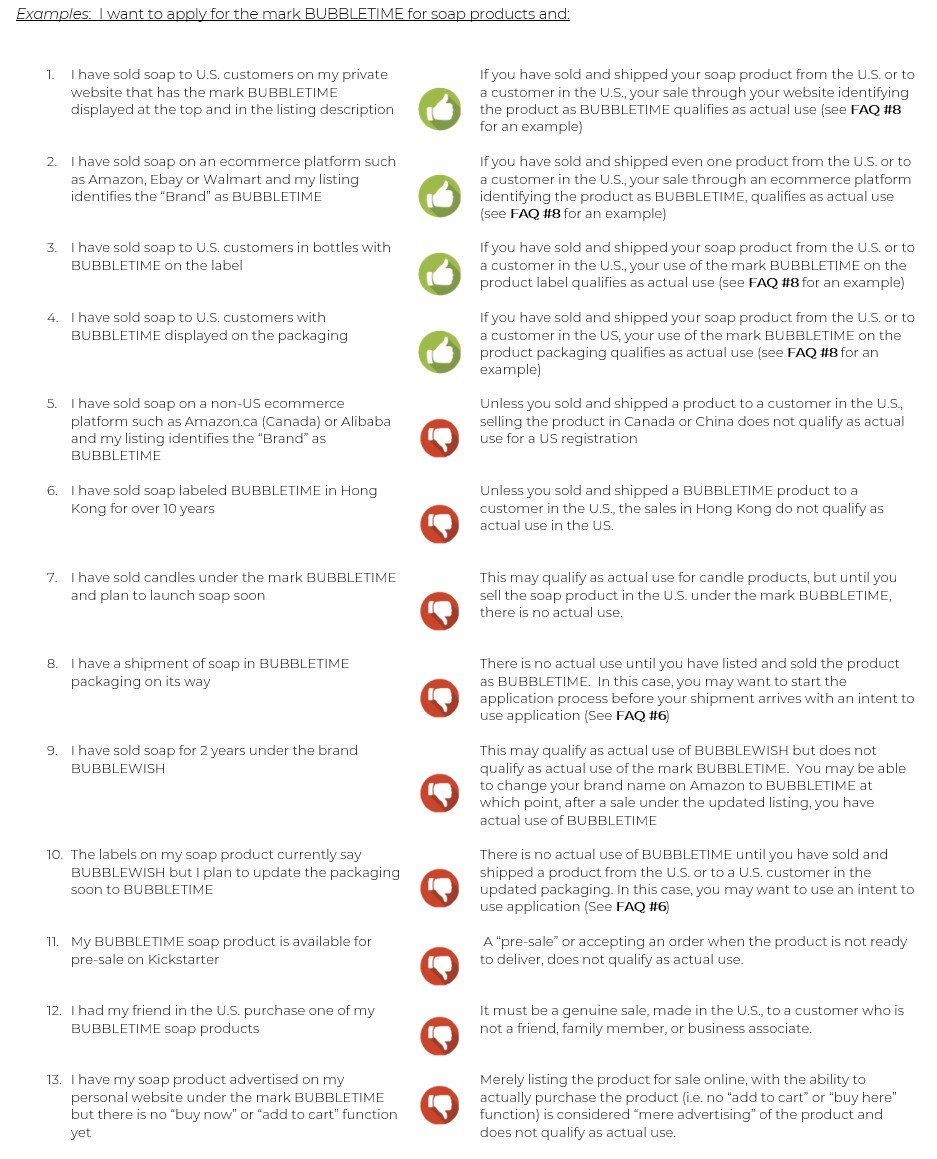
When we file your AU application, you will make a declaration, under oath, that the products or services listed in the application have been sold in US commerce, and you will be required to provide the dates of first sale. Accordingly, the AU application will list only those products or services you have actually sold as of the date of the application. If your application includes products or services not already sold, your entire application could be invalidated. If you do not meet the “sale” requirements of an AU application, it may be in your best interest to pursue an “Intent to Use” application. Please see our FAQ #6 for more information about Intent to Use applications.
Either way, using the methods outlined in FAQ #30, we will work together to determine the number of “International Classes” to include in your application. Our fees for standard description one-class to five-class AU application are:

- Note that a $200 USPTO per class Filing Fee Surcharge applies to applications with “custom” descriptions not found in the Trademark ID Manual, as explained FAQ #10b.
Please see our FAQ #10 for more information about fees and our FAQ #11 for details about what is included in the Service Fee.
+ FAQ #6a. What is an “Intent to Use” application?
If you are not currently selling your products or services in the United States but would like to begin the application and accruing trademark rights, we can file an “intent-to-use” (ITU) application. Some benefits of an ITU application are:
An ITU application allows you to firm up your trademark rights before launch. This means, potentially, you will have registered trademark from the day your listing goes live. An ITU application gets your mark in line at the USPTO, thereby preventing any after-filed applications that might cause “likelihood of confusion” (See FAQ #26 for more information about “likelihood of confusion”) and block your mark from being registered. Some business owners like to have the mark "in line" before they go live, especially if they have a unique mark. If there is a question about whether you have actual use of your mark (See FAQ #5), an ITU application allows you the time you need to show proper use and create an acceptable specimen (FAQ #8). The ITU application is a two-step application where we first file the application (Step One), and then, at a later date, file proof of your use of the mark (Step Two). The fees for the standard description ITU application (Step One) are in the table below:

- Note that a $200 per class USPTO Filing Fee Surcharge applies to applications with “custom” descriptions not found in the Trademark ID Manual, as explained FAQ #10b.
+ FAQ #6b. What products or services can I include in my "Intent to Use" application?
Many times, figuring out which products or services to include in your application (or not) is the hardest part of the trademark application process. Many business owners create a brand with the intent to sell several, even hundreds, of different products or services under their brand at some future time. And in many countries, you can “reserve” your trademark for entire categories of goods or services, even if you do not sell those goods or services. The trademark system in the United States is unique in that your trademark rights in a brand extend only as far as those products you can prove you are actually selling in connection with your mark. As discussed in FAQ #6a., with an intent to use application, we supply the “proof” in Step Two.
An ITU application can list up to as many products or services as you realistically intend to launch in the next 12-14 months (or longer if you are comfortable with extra fees).
Roughly 7-8 months after we file the application, assuming all goes well, the USPTO will issue a Notice of Allowance (NOA) triggering a six-month period in which you must file a Statement of Use (SOU) proving you are using your trademark in connection with the products or services identified in the application. We may be able to extend the time to prove use, but extension requests can quickly become expensive (FAQ #6c., Option 3). Therefore, you should list only those products or services in the application you realistically believe you will sell in the next 12-14 months, unless you are comfortable paying repeated extension fees.
Again, including products or services in the application simply to "reserve" them, but without any real intent of selling them, is not permitted under US law, and can be detrimental to your application for the following reasons:
- The USPTO is suspect of applications that include several different products or services that are otherwise unrelated, so they apply greater scrutiny to review your application, which could result in unnecessary refusals.
- Relatedly, the more products or services you list, the greater the chance of running into “likelihood of confusion” with another mark (See FAQ #26 for a discussion of “likelihood of confusion), blocking your trademark application. For instance, if you include “toothbrushes” in your application, and there is a prior similar mark out there for dental cleaning supplies, your application could receive a refusal because there is someone ahead of you selling similar products. Listing “toothbrushes” may be worth it if you have immediate plans to sell toothbrushes but is an unnecessary risk if there is only a remote possibility you will eventually include this product or service.
- If another seller can show you are not selling or have no real intent to sell a product or service you claim to sell, the seller can move to cancel your entire application for "non-use."
- The more classes, the more expensive the application. Our FAQ #30 provides an in-depth discussion about determining product or service classification. The additional classes, and added costs, are likely worthwhile for the products or services you actually intend to sell but would be a waste of resources if you are not likely to ever sell the product or service and will eventually have to delete them from the application, as discussed below (#6c., Option 2).
+ FAQ #6c. What happens after my "Intent to Use" application is allowed (Step Two)?
Again, roughly 14 to 18 months after we file the application (the “deadline”), if all goes well, we must proceed under one of the below “Step Two” options. As the deadline approaches, we will discuss which option is best for you at that time
- Option 1 - File a Statement of Use (“SOU”) – All products and/or services. As soon as you are selling all of the products and/or services identified in your application, we can file an SOU in which you will declare, under penalty of perjury, that you are selling all products or services and we will file the necessary proof. In that case, you should receive registered rights in all products. The USPTO filing fee for the SOU is $150 per class covered by the SOU and IdeaLegal’s flat fee for preparing and filing the SOU is $400, so depending on the classes covered by your application, Step Two fees under this option are:

- Option 2 – File a Statement of Use (“SOU”) – Some products and/or services. If by the deadline you are selling some but not all of the products or services, and you would like to advance the application to the next phase of registration, we can delete those products/services you are not selling from the application and file an SOU for only those products/services you are selling. In that case, you should receive registered rights in only those products remaining in the application after deletion. The USPTO filing fee for the SOU is $150 per class covered by the SOU and IdeaLegal’s flat fee for preparing and filing the SOU is $400, so depending on the classes covered by your application, Step Two fees under this option are:

- Option 3 - File a Request for Extension (“RFE”). If you cannot show proof of use before the deadline, or if you want to wait to file the SOU until you are selling all (or more of) the goods or services in your application, we can file an RFE which will extend the deadline by an additional six months. You can request up to five RFEs. The USPTO filing fee for an RFE is $125 per class covered by the application, and IdeaLegal’s flat fee for preparing and filing the request is $300, so depending on the classes in your application, Step Two fees under this option are:

- Option 4 - Do Nothing. Perhaps your business plans will have changed. If we do not proceed with Option 1, 2 or 3 above, before the deadline, your application will be marked “abandoned.” There are no additional fees under this option.
+ FAQ #7. What if I am selling some products or services now, but intend to sell more products or services in the future?
In the situation where you are selling some products or services now but intend to sell more products and/or services in the future, you have the following options:
Option One: Cover Only the Products or Services You are Currently Selling in an AU Application. You can apply for registration of your mark now as to only those products or services you are actually selling, using the Actual Use Application (see FAQ #5). If you want full trademark protection for future products or services, you can always file a second trademark application. The cost of a new application will be the same as any new application at the time you file, likely similar to the costs of a new application today.
Option Two: Wait Until You Are Selling All Products or Services and Cover Them All in an AU Application. You could wait until you have launched all future products or services and file an Actual Use application at that time, covering all products and services, and avoiding the additional expense of proving use later in the process (FAQ #6c).
Option Three: File One Application AU for the Products or Services Are You Selling, and ITU for the Future Products or Services. You could file an application that covers the products or services you are currently selling on an Actual Use basis (FAQ #5), and the products or services you intend to launch in the next 12 months on an Intent to Use basis (FAQ #6). We can do all of this in one application. If the idea is to file your application as quickly as possible, and to keep costs as low as possible, we suggest Option 1.
If you are close to launch of all future products or services and a quick application is not an important factor for your business, we suggest Option 2. If you can afford to have as much trademark protection as possible, including the earlier trademark priority that comes with an ITU application, we suggest Option 3.
+ FAQ #8. How do I prove use of my trademark (a specimen)?
At the time we file an application (see FAQ #5) or a Statement of Use (see FAQ #6c) we must file a “specimen” proving use of your mark on the goods or services identified in the application.
We can prove use of the trademark on goods by submitting photographs of the mark on the products themselves, product packaging, or an online listing properly identifying the mark. It is important to note that a digitally created mockup of a label or packaging will not be accepted by the USPTO. In other words, you must provide a photo that is not digitally altered in any way (do not remove background or edit color).
Example: If you applied for the mark MAMA BEAR (word mark) and/or
 (design mark), for baby wipes, the following apply:
(design mark), for baby wipes, the following apply:
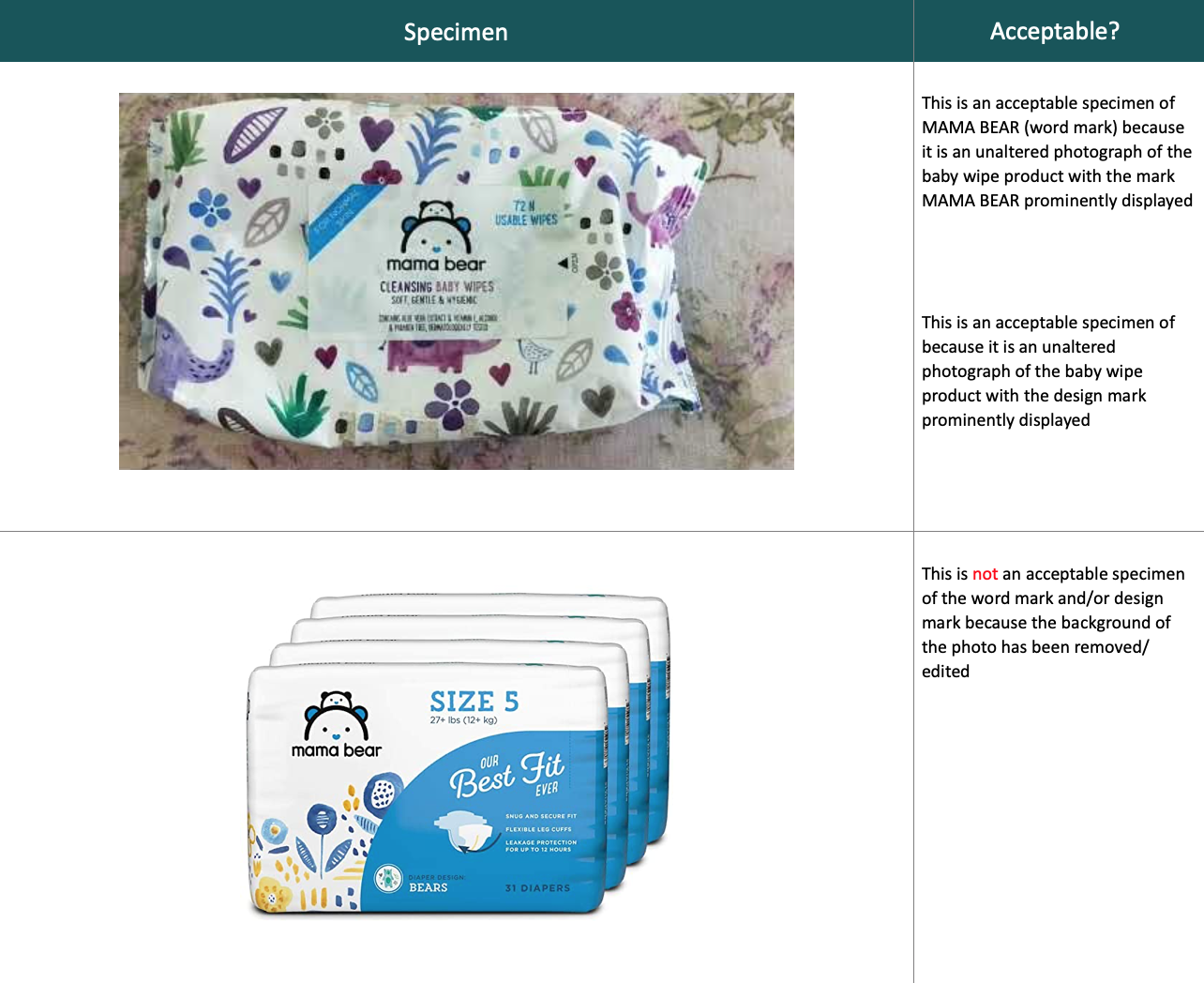
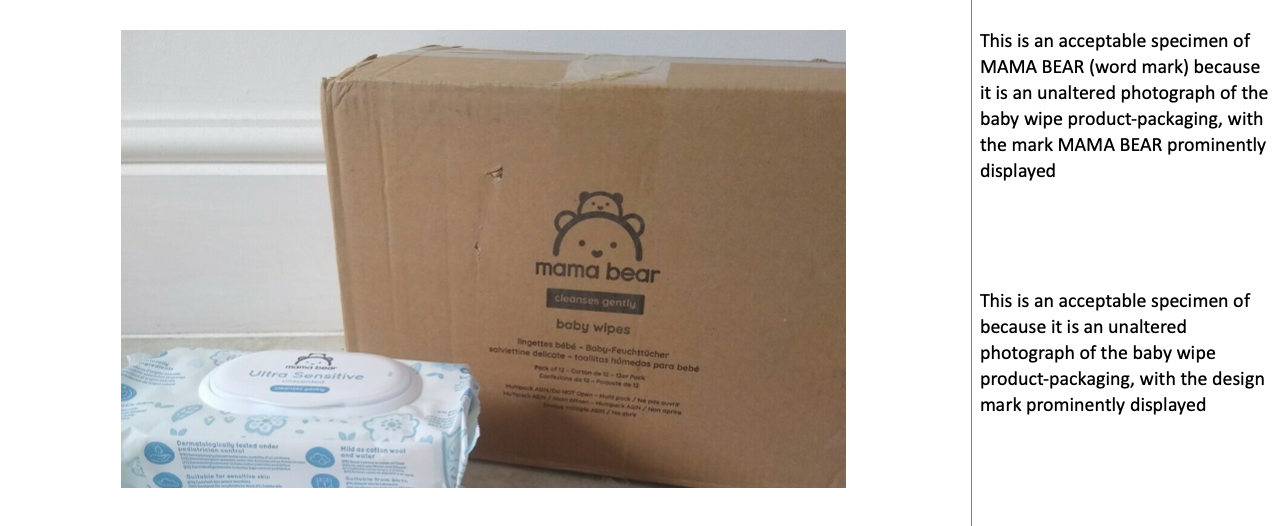
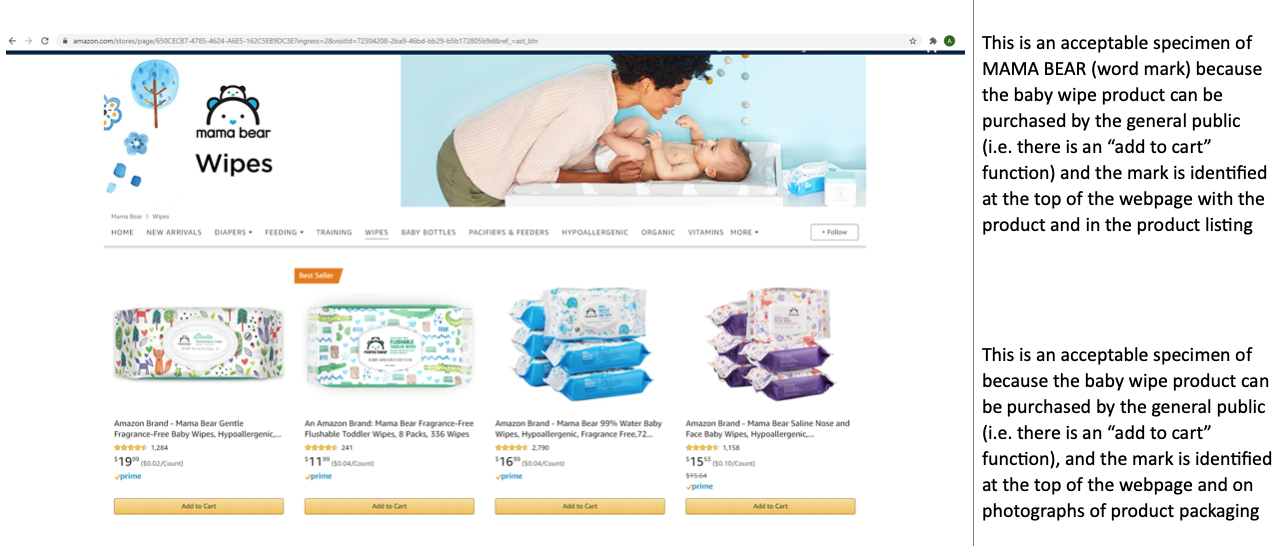
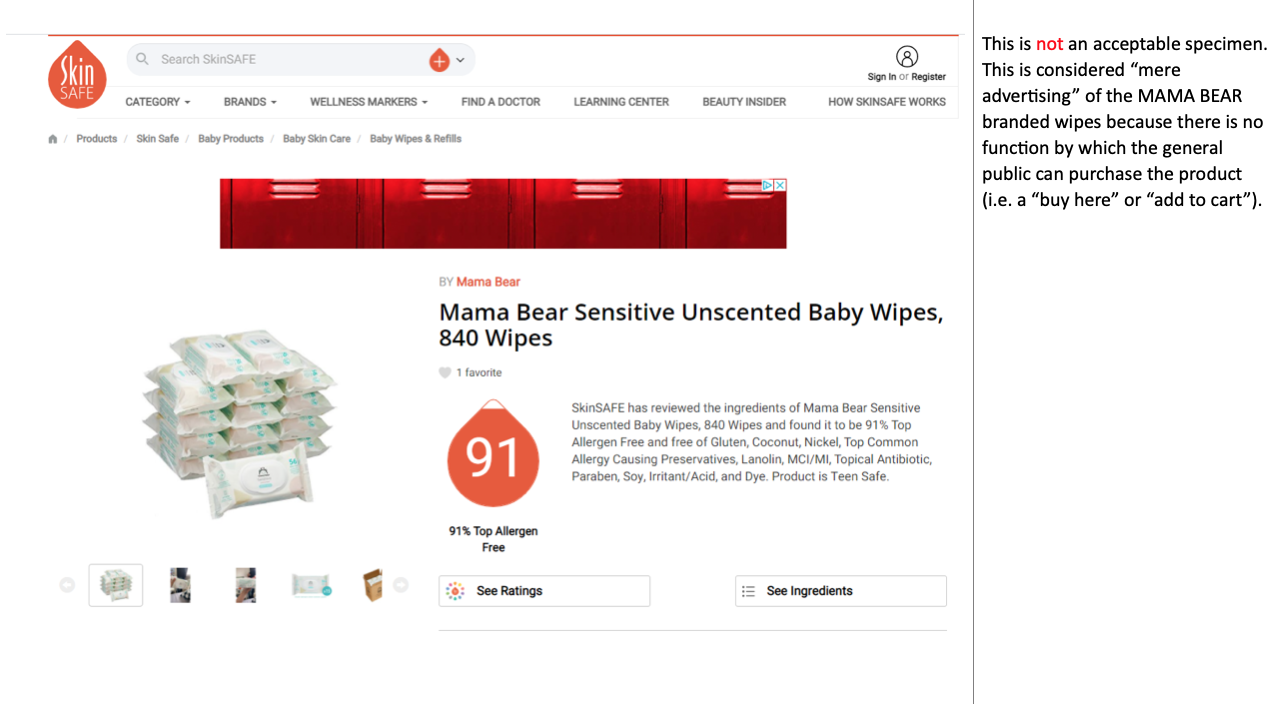

If the trademark covers services, a website page or brochure using the trademark and offering the services, or an invoice for services having the trademark on it, can work for a specimen.
+ FAQ #9. What is a trademark search and do I need one?
The primary purpose of a trademark search is to determine whether a mark is available for use and registration, or whether there are other marks that may block your proposed use or application of the mark based on “Likelihood of Confusion.” Please see our FAQ #26 for a detailed discussion about Likelihood of Confusion.
You are not obligated to search and clear your trademark before applying for registration. However, if you file an application without a search, you risk having the application denied for reasons that could have been discovered with a search and clearance.
We offer three types of trademark search services:
High-level Search: This search provides a high-level (overview) brand search of USPTO records for relevant pending applications and registrations and provide an opinion based on our results. This search is limited to trademark records at the USPTO but gives us a clearer picture of whether or not your mark will register at the USPTO. If you proceed with a high-level search, we will send you an engagement letter and invoice for the service. We aim to provide search results within three business days of receiving the signed engagement letter and paid invoice. We offer the high-level search, which covers up to three classes, for a flat fee of $500 per search.
In-House Comprehensive Search: This search provides a comprehensive search of registered marks (USPTO Records) and unregistered uses (online and business listings). We analyze the results and provide you with a report of potential obstacles (or not) to registration of your mark as well as "common law" uses outside of registration (this is further explained in the report), which may tell you if there’s a risk of receiving a “cease and desist” letter from a competitor, even if they haven’t registered the trademark. We aim to provide search results within seven business days of receiving the signed engagement letter and paid invoice. We offer the in-house comprehensive search for a flat fee of $1,200 per search.
Vendor Comprehensive Search: This search is performed by an outside vendor with the ability to search everything offered under the In-House Comprehensive Search + state trademark records. If you proceed with a vendor comprehensive search, we will send you an engagement letter and invoice for the service. Once we receive the signed engagement letter and paid invoice, we will order the search from our vendor. The vendor generally provides results within three business days. We will then review the results and provide our report to you within seven business days of receiving the vendor results. We offer the Vendor Comprehensive search for a flat fee of $1,800 per search.
Our search services and fees are separate and in addition to the application fee. The search fees discussed above cover the search of one trademark. We may be able to search minor variations of a mark within the same search (i.e. FUZZY BLANKETS as well as THE FUZZY BLANKET or A FUZZY BLANKET), but variations in distinctive portions of the mark require separate searching. For instance, a search for THE FUZZY BLANKET would produce much different results (and require separate analysis) than THE COMFY BLANKET. If you are considering several marks, we suggest you start with the mark you like the best and, hopefully, the results come back in your favor and you are not required to search your second choice.
+ FAQ #10a. What are the fees for an application?
The total cost to file a US trademark application depends on two factors:
Whether you file an “Actual Use” application, or “Intent to Use” application (Please review our FAQ #5 for more information about Actual Use applications, and our FAQ #6 for more information about Intent to Use applications); and
The number “International Classes” included in your application. (Please see our FAQ #30 for information about properly classifying your products and services).
All applications are comprised of two fees:
Our pre-negotiated Service Fee for those services outlined in our FAQ #11; and
A Filing Fee (sometimes called a government fee) charged by the United States Patent and Trademark Office.
Actual Use Applications
If you file an Actual Use application the following Service Fees and Filing Fees apply based on the number of International Classes covered by your application:

Intent to Use Applications
As discussed in detail at our FAQ #6, if you file an Intent to Use application, it is a two-step process where we first file the application (Step One), and then, at a later date, file proof of your use of the mark (Step Two). Fees are incurred at Step One and Step Two as follows:
STEP ONE – File the Application: If you file an Intent to Use application the following Service Fees and Filing Fees apply based on the number of International Classes covered by your application:

STEP TWO - File Statement of Use: If all goes well, roughly 6 – 8 months after we file your Intent to Use application, the USPTO will issue a Notice of Allowance which will trigger a six-month deadline by which you must file a Statement of Use (SOU) proving you are using your trademark in connection with the products/services identified in the application. The following Service Fees and Filing Fees apply for the SOU, which will be invoiced at the time we prepare the SOU:

If you have not started selling your products/services and cannot prove use of your mark before the SOU deadline, we can file a Request for Extension (RFE) which will extend the deadline to file your SOU by an additional six months. We can discuss what option is best for you as the deadline approaches but if you decide to request the extension, the following Service Fees and Filing Fees apply for the RFE, which will be invoiced at the time we prepare the RFE:

+ FAQ #10b. When does the surcharge for “custom” goods descriptions apply?
Although the filing fee for a standard one-class application is $350 per class, the USPTO recently introduced a $200 “surcharge” for custom goods and services descriptions. “Custom” descriptions are those that cannot be found in the list of preexisting descriptions in the Trademark ID Manual (TMID). These are products that, for whatever reason, the USPTO has not yet pre-described.
For example, “Cosmetic apparatus for microdermabrasion” can be found in the TMID and the USPTO filing fee would be $350. But “Cosmetic apparatus, namely, electric blackhead removal tool for use on skin” is not in the TMID and the USPTO filing fee would be $550 for this product. There is no way to describe this tool in a way that fits the TMID. This will be the case for some products. We will do our best to describe your products according to the descriptions in the TMID, to save you money, but please understand that certain products are not yet described there, and if your product is one of these, the surcharge will apply.
+ FAQ #11. What is and not included in the flat fee application cost?
The application flat fee includes:
- The steps outlined in FAQ #2 for preparing and filing an application based on the information you have provided to us;
- Reporting your serial number to you;
- Reporting the publication of your application; and
- Reporting the registration of your mark, and sending you an electronic certificate of registration.
The flat fee does not include:
- Searching the availability, or commenting on the availability, of your trademark (see FAQ #9);
- Telephone consultations—these can be arranged by appointment only and will be invoiced at our hourly rate of $400 per hour;
- Filing change of information forms such as changes to the owner name or address (see FAQ #20)
- Reporting, researching, and responding to office actions (see FAQ #12);
- Enforcing your trademark rights;
- Negotiations or dispute resolution; or
- Litigation, including opposition and cancellation proceedings.
+ FAQ #12. What happens if my application is refused?
The trademark office reviews each application to determine if it qualifies for registration and can refuse registration on a variety of grounds by issuing an Office Action. We use our experience and professional judgment to try to avoid Office Actions, but Office Actions are not infrequent, and, to a degree, we have little control over the trademark office's decision to issue an Office Action. This is especially true when the applicant has elected not to have a professional search and clearance of the mark performed, to assess its risk before proceeding.
Some Office Actions are primarily technical in nature and will not significantly affect the scope or your trademark rights. For instance, an examining attorney might suggest a clarifying word to the goods or services description or ask that we “disclaim” (see FAQ #24) a word that is objectively descriptive or generic. In those instances, we will respond to the Office Action on your behalf without involving you in the process and at no additional cost to you.
Most Office Actions require a more substantive review and response, and we perform these services at our hourly rate of $400. If a substantive Office Action issues, we will forward the Office Action to you and report some options and the next steps generally available. Because of the expense, we will not then perform any of the services outlined in our reporting email without first obtaining your consent.
Importantly, our reporting email will not provide any analysis or advice about which option is best for your particular situation. This is because we have not yet analyzed the office action in any detail, researched the strength or validity of the refusal, or, when necessary, investigated the owner’s use of the marks cited against you. Again, these are services performed at our hourly rate and therefore will not be performed without your consent. In almost every situation, we will suggest you start with research services first, so we can better understand your position and provide advice on your best option for proceeding. Without researching the issue first, we simply do not know which option is best for you. Depending on the nature of Office Action, research can take anywhere from 1 -2 hours ($400 - $800). Once we properly research your position, we will provide an opinion report laying out the strengths and weaknesses of the refusal along with targeted advice as to which option we recommend in your situation.
Again, the best option for your situation depends on the particulars of your mark and grounds for refusal. But these are some options that may be available to you:
Respond to the Refusal. You have the option of challenging the refusal with argument and evidence. Depending on the basis of our argument, and whether it is necessary to prepare and attach evidence, a challenge to the refusal can take anywhere from 1 to 5 hours ($400-$2,000). We will have a better idea of the cost once we preform the research discussed above.
Seek Consent. When your mark is refused registration based on “likelihood of confusion” (FAQ #26) our opinion report may suggest you ask the owner(s) of the cited mark to consent (agree) to the registration of your mark. If they agree, we will prepare a “consent agreement” and ask them to sign it, and then file the consent agreement with the trademark office as part of an office action response. Consent agreements almost always convince trademark examiners to drop the refusal and let your application proceed. Generally, it takes about 3 hours ($1,200) to reach out and seek consent and, assuming consent is given, to prepare a consent agreement, get it signed, and submit it to the trademark office.
Attempt to oppose or cancel the cited marks. When your mark is refused registration based on “likelihood of confusion” (FAQ #26) our opinion report may suggest you file a Notice of Opposition or Petition for Cancellation (the appropriate filing depends on where the cited mark is in the registration process) which, if successful, would clear the path for registration of your mark. Filing a Notice or Petition, and then (hopefully) negotiating a settlement permitting your application to proceed, can take anywhere from 3 hours of attorney time (usually when the owner of the cited mark does not appear to defend its application/registration) to 20+ hours of attorney time if the proceeding is strongly contested. In addition to attorney’s fees, the USPTO filing fee for a Petition is $600. We will have a better idea of the cost once we preform the research discussed above.
Refile a different type of mark or product/service. Our opinion report may conclude that your best option is to refile the application for a different type of mark (i.e. refile a design mark instead of a word mark) or to refile the application for the same mark covering a different product or service. In that case, the cost is the cost of filing a new application (Please see our FAQ #10 for current pricing information).
Make no response and rebrand. You may decide on your own, or based on our research findings, that you do not want to put any more resources into your mark and opt instead for a rebrand. From a trademark perspective, the cost of rebrand is the cost of filing a new application (Please see our FAQ #10 for current pricing information).
If you decide not to respond to the office action, or if the response is unsuccessful and you decide not to contest it further, the application will eventually (within a few months) be marked as “abandoned” in the trademark office database. At that point, it will no longer serve to prevent he registration of similar marks (see FAQ #1). You can mitigate the risk of a “likelihood of confusion” (FAQ #26) refusal by thoroughly researching whether your mark is available or asking us to perform a search as described in FAQ #9.
+ FAQ #13. Can I add new products or services to my trademark after the application is filed?
If you have already filed your first trademark application and then want trademark protection for new goods or services in the same class or new classes under the same brand, you will need to file a new trademark application at the costs outlined in FAQ #10. The trademark office does not let you tack on new products, services, or classes to an application after it has been filed. This is because the trademark office examines your application for a likelihood of confusion with prior marks (FAQ #26) based on the set specific goods or services in the application.
If the product or service is in the same class, though, it may be “related” to the products or services listed in your first application, thereby giving you sufficient protection without needing to pay more (i.e., if you registered your brand for blankets and are now selling sheets, you would not necessarily need to file another trademark application because it is common for the same seller to offer both blankets and sheets).
+ FAQ # 14. I filed on my own and got a refusal. Can you help?
Yes, we are happy to help with your ongoing application.
Our fee for onboarding the application is $250, which includes our firm’s docketing and reporting services, and preparing the attorney appointment paperwork. In addition to that, if the refusal relates to purely technical matters (for instance, an examining attorney might suggest a clarifying word to the goods description or ask that we “disclaim” (see FAQ #24) a word that is objectively descriptive or generic), we will also quote the cost of the Office Action response, which is usually between $200-400. If the refusal is substantive (for instance, your mark was refused as descriptive (FAQ #24) or likely to be confused with a mark already in the USPTO database (FAQ #26), we will need to begin by doing the research that permits us to recommend a path forward and let you know the cost involved. See FAQ #12 for more information about how we can address an Office Action refusal.
+ FAQ #15. Will my personal information and address be made public?
The USPTO requires us to name the applicant (which may be a company or an individual, per FAQ #19), and that application must be signed by the applicant or its authorized representative. So these two pieces of information are, by necessity, part of the public record, for those who know how to search for it in the USPTO database.
With respect to your address, however, although you need to provide what’s called a “domicile street address,” you have the option of keeping that address hidden by providing a separate “mailing address” as well.
When the applicant is an individual, the domicile street address is the individual's legal place of residence. When the applicant is a company, the domicile street address is the where the senior executive ordinarily conducts business. This could be the corporate headquarters if the senior executive ordinarily conducts business from the office or a senior executive's home address if the senior executive conducts business from a home.
A domicile street address cannot be a registered agent address, a mail forwarding/receiving address, a virtual address, or a P.O. Box. The USPTO uses software to check all addresses and if it discovers the domicile street address is a registered agent or mail forwarding address, it will refuse your application, causing expense and delay.
Understandably, many applicants are reluctant to make their domicile street address public. If you choose, we can hide the domicile street address in the application by providing a second publicly viewable "mailing address" of your choice.
+ FAQ #16. Do I have to be a U.S. citizen or a have a U.S. address to file an application?
Not at all! We have been fortunate to work with companies from all over the world. The USPTO will accept and review trademark applications from any country
+ FAQ #17. Does my trademark have to match my company name?
No! In fact, many times your company name cannot be registered as a trademark. Your company name is rarely the same as your public-facing “brand” names. You may be surprised to learn that some of the most famous trademarks in the world are owned by companies most of us have never heard of.
Take for instance the well-known baby brand, Gerber:
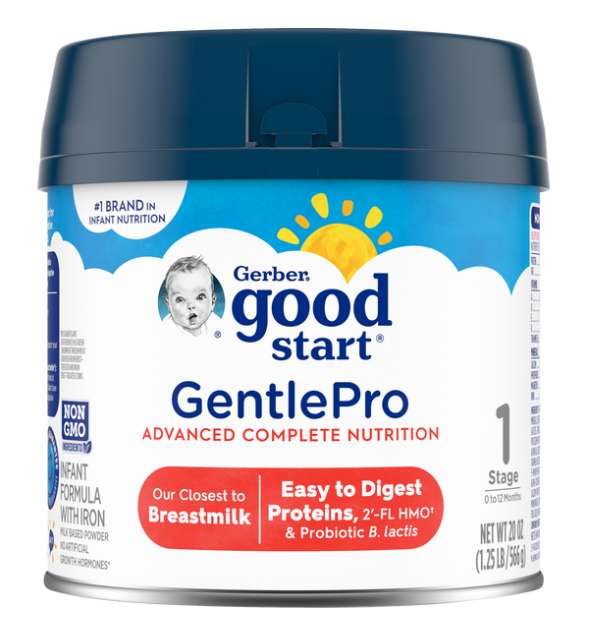
The above product utilizes at least three public-facing trademarks including:
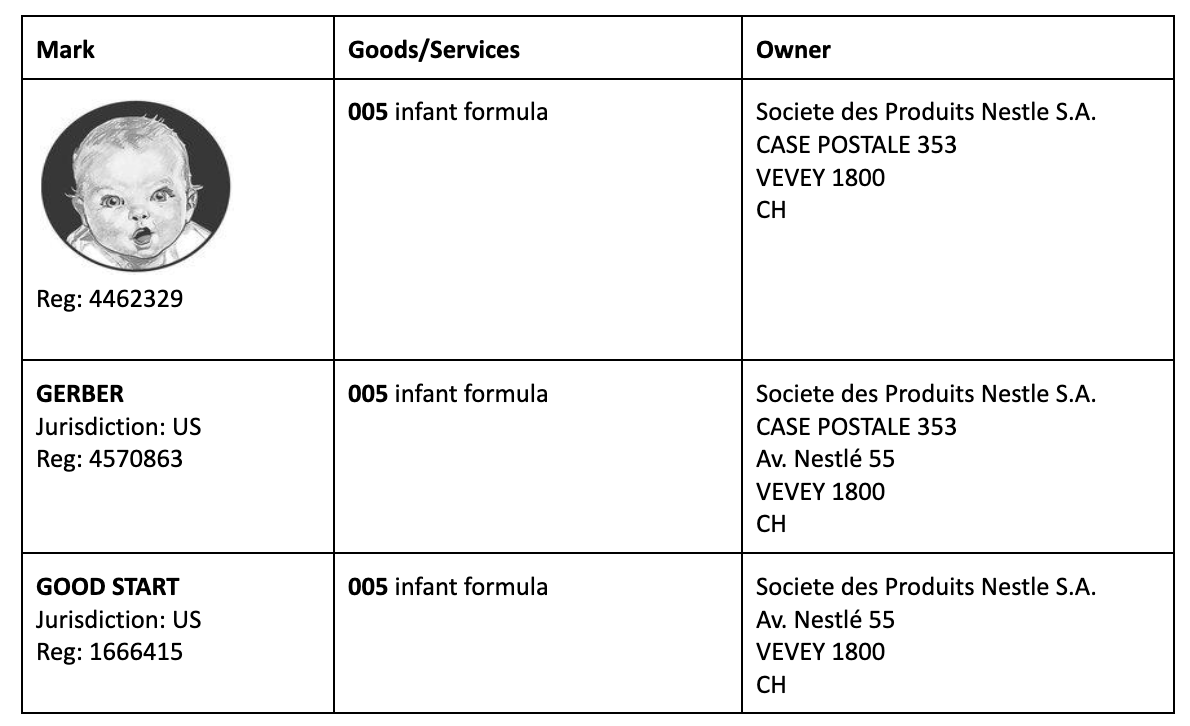
You may be surprised to see that all the above trademarks are owned by the Swiss company, Societe des Produits Nestle S.A. In the above example, the company, Societe des Produits Nestle S.A., is not the public-facing brand and is therefore not used as a trademark.
Also note: even if your company name generally does match your brand but includes “LLC” or “Inc.,” your trademark application does not need to include that corporate designation. For instance, Apple Inc. owns the mark APPLE.
+ FAQ #18. Why do you talk about my trademark using CAPITAL LETTERS?
It is standard practice in the United States to use all capital letters when we file a trademark application. Capitalization in a trademark registration means that you are not limited to any particular case or font style. It leaves you open to use those letters however you like including a mix of Caps and lower case.
The USPTO will always identify a trademark in its database in all capital letters. As such, we also always identify the mark in the USPTO filing in all capital letters. An example:
The mega-retailer Petco identifies its brand on the Petco website as “Petco” (a mix of upper- and lower-case letters):
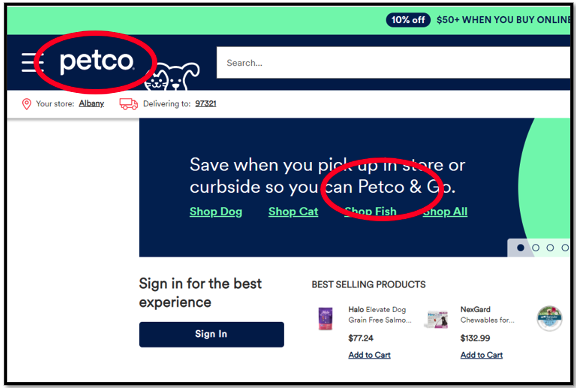
However, Petco’s trademark registrations are all identified in the USPTO database as PETCO (all caps). For instance:

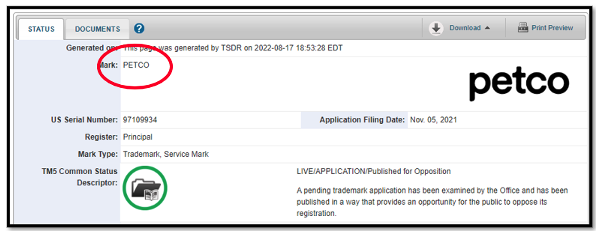
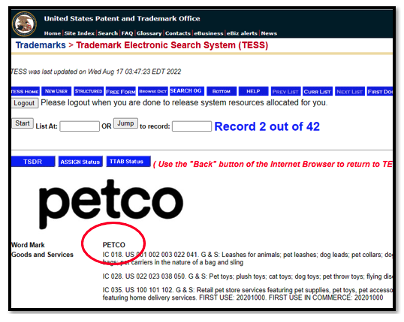
When we file your application, we will do so using all capital letters.
+ FAQ #19. Is it better to use my personal name or my business name in the application?
The trademark application should be in the name of the individual or entity who owns the rights in the mark, whomever you consider that to be. There are no advantages or disadvantages one way or the other, from the standpoint of the trademark office. There may be business or tax advantages, but we do not have expertise in those areas. Those questions should be discussed with your business and tax advisors.
+ FAQ #20. Can I change my name or address after I file the application?
Yes. Updating information listed in your application is handled differently, depending on the information updated:
Updating your address: Updating your address is a straightforward matter but it must be filed by the attorney of record on the application (that’s us!). If you attempt to file the change of address on your own, the UPSTO will reject the filing since you are not attorney of record. We charge a flat fee of $100 to file a change of address form.
Updating your name, or changing from individual to company: When you apply for a trademark in one name (whether it be an individual or a company) and you later want to transfer the trademark rights to a different individual or company, you will need to assign and record the transfer of rights as follows:
Step 1: Assign the Rights by Written Assignment. Step one is to assign ownership from one party to the other by a written assignment. The written assignment requires specific language to be a valid transfer of trademark rights and a signature of the transferring party.
Step 2: Record the Assignment. Similar to the process of purchasing a home, you have to record the assignment document so it becomes part of the public record. The assignment document is recorded at the USPTO and becomes part of the official trademark record.
Our flat fee to prepare the assignment document and record the same at the USPTO is $500 and the USPTO filing fee is $40-$100 (depending on how many marks are transferred by the same document).
As you can see, making a name change is not a simple or inexpensive process. As such, if timing allows you to make the name change before you file the application, we suggest you make the change first.
+ FAQ #21: Can I apply for several products under Class 35?
The availability of a Class 35 application is commonly misunderstood and something the USPTO has been cracking down on recently. Class 35 is reserved for sellers offering "retail services" under their mark. As an example, if you sell bath products under the mark BUBBLETIME, and you have your own website with the mark BUBBLETIME, you are providing online retail services under the mark. Similarly, if you have a store front at a mall or farmer's market with the store front as BUBBLETIME, you are providing retail services under the mark. Conversely, if you merely sell BUBBLETIME-branded bath products on a third-party e-commerce platform (i.e. Amazon, eBay, Etsy) or third-party store front (i.e. Target or Shop-N-Save), you are selling goods under the mark; you are not providing retail services under the mark.
We have seen the USPTO push back on applicants who try to classify their goods as a Class 35 service.
If you sell your goods though a third-party retail outlet (i.e. Amazon or target) and on your own branded website, then you have the option of filing an application covering the goods themselves and/or a Class 35 application covering retail services.
A registration in the individual goods gives you registered trademark rights in the goods themselves. This means you could potentially prevent other sellers from using a confusingly similar mark to sell similar products.
A registration in the retail services give you registered trademark rights in the retail services, not the goods themselves. This means you could potentially prevent another seller from offering an online store with a similar mark selling similar goods but not necessarily against another seller selling a particular good under a similar mark.
The biggest benefit of a Class 35 registration is that it is a one-class application, so it is less expensive than a multi-class application (see FAQ #10 for fees) if you sell products across several international classes(FAQ #30).
The biggest drawback to a Class 35 registration is that if you ever need to enforce your rights against another company for a particular product, your trademark registration does not directly cover that product, only the service selling it. So your rights are more diluted and third-party sales platforms may decline to remove infringing listings if you only have registered rights in your online retail services and not the goods themselves.
If the idea is to cover many products with the least amount of cost, Class 35 may be the way to go. If the idea is to have broader, enforceable trademark rights, then we suggest you file for the goods themselves.
+ FAQ #22. Reserved
+ FAQ #23. Do you provide services for non-U.S. Filings?
We do! There are two filing options for jurisdictions outside the U.S.:
Direct Filing: A Direct Filing is where you file directly into a jurisdiction’s system. For instance, if you want a trademark registration in Japan or Canada, you can direct file into the Japanese and Canadian trademark systems. Generally, you must retain an attorney licensed to file into your desired jurisdiction. Using the above example, you would need to hire an attorney licensed to practice in Canada to file the Canadian application and Japan to file the Japanese application. It is more cost-effective to directly hire an attorney licensed to practice in your desired jurisdiction. We are only licensed to file into the U.S. system. However, if you prefer, we can arrange for a direct file application with local counsel, on your behalf. The fees for a direct file application vary (depending on the jurisdiction) but you can usually expect between $1200 - $1500 in local fess (for local counsel and local filing fees) + $600 as our flat fee for corresponding and coordinating with local counsel.
Madrid Filing: The Madrid system is a centrally administered international system where you can apply for registrations in multiple jurisdictions all at once. Below is a summary of the Madrid process and related fees:
Step 1: An application or registration from your “Home Country”. To use the Madrid system, you must first have a valid trademark application or registration from your "home country" (where you or your business is based) and your "home country" must be a member of the Madrid organization. For instance, if your business in based in Canada, you must first have an active Canadian application or registration. You can find a list of Madrid-member countries here: https://www.wipo.int/madrid/en/members/ If you are a U.S. based individual or company, we can help you first file a U.S. application (fees are at FAQ #10). If you are a non-U.S. based individual or company, please work with a firm in your home country on a Madrid Filing.
Step 2: An International Registration. Next, you must turn your home country application or registration into an International Registration (IR). We apply for the IR at the World Intellectual Property Organization (WIPO) and your home country certifies your application/registration to WIPO. The IR is what gets filed into the various jurisdictions designated under Madrid. Our flat fee for an IR registration is $600 and the Government fees are approximately $750 (fees vary by currency exchange rate). As a note, some home countries also charge a “certification” fee (the certification fee for the U.S. is currently $200).
Step 3: Designate Madrid Jurisdictions. You can choose as many or as few Madrid designations as you wish. Generally, if you have two or more jurisdictions you would like covered by the IR, then a Madrid filing makes the most sense from a cost perspective. Anything less than two, and it usually makes more sense to file directly into the non-US trademark system (a “direct file”). Our flat fee per designated jurisdiction is $250 and the government fees vary by jurisdiction. If you’re curious, you can run a fee calculation at WIPO here: https://www.wipo.int/madrid/feescalculator/ (note fees are in Swiss Francs).
A couple of notes. For the EU, we can designate the European Union as a single designation covering: Austria, Belgium, Bulgaria, Croatia, Cyprus, Czech Republic, Denmark, Estonia, Finland, France, Germany, Greece, Hungary, Ireland, Italy, Latvia, Lithuania, Luxembourg, Malta, the Netherlands, Poland, Portugal, Romania, Slovakia, Slovenia, Spain, and Sweden. As you can see there are a handful of countries in the region not covered by an EU designation. Notably absent are Norway, Switzerland, Ukraine, and soon, the UK. The “absent” counties are members of Madrid but must be designated separately from the EU designation.
Example: if you hold a one-class U.S. application and want file into Australia, EU, UK, Japan and Singapore, the estimated fees are:
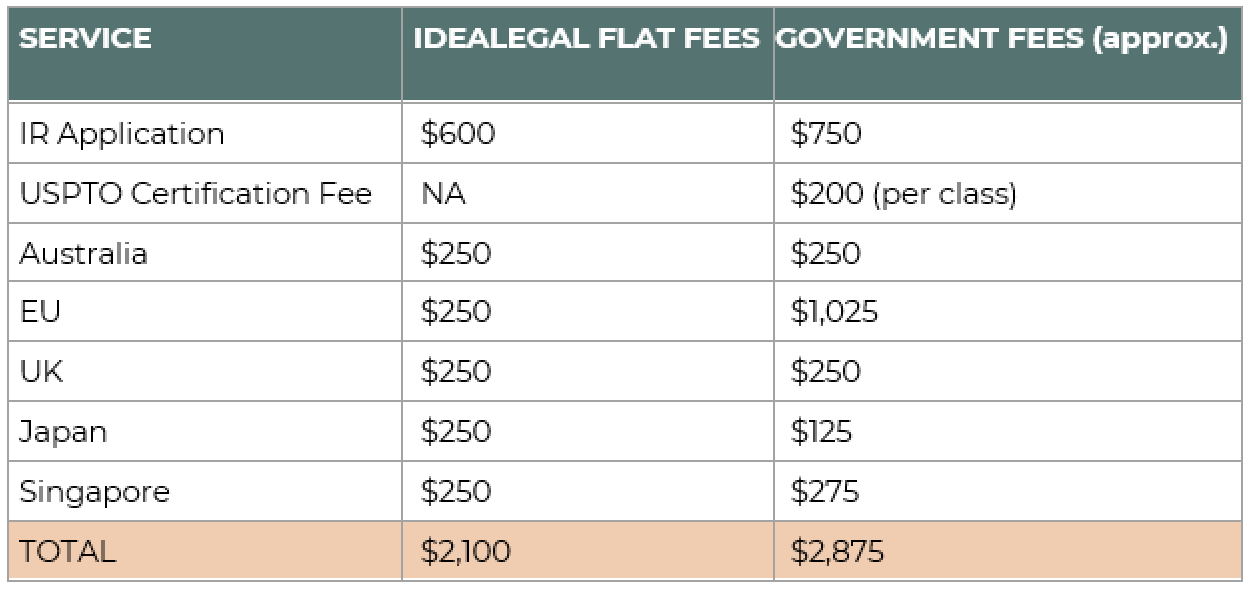
+ FAQ #24. What if my mark includes common words?
For good reason, the trademark office does not allow any one person to own exclusive rights to certain words we generally refer to as “descriptive” words. These words include:
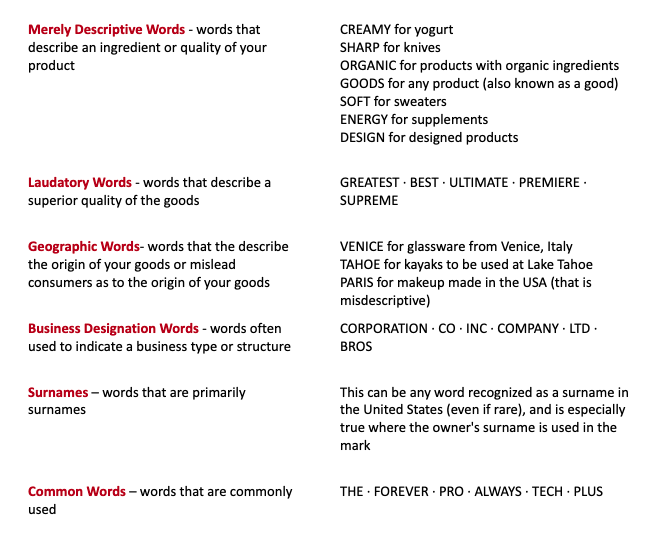
How we proceed depends on whether part of your mark is descriptive or your entire mark is descriptive.
When part of your mark is descriptive:
If your mark contains one or some (but not all) words that are descriptive, you will likely need to “disclaim” the descriptive words from your application. A disclaimer is a statement you include in your application to indicate that you do not claim exclusive rights to an unregistrable portion of your mark. It says, “No claim is made to the exclusive right to use [WORD] apart from the mark as shown.” A disclaimer does not physically remove the words from your mark or affect the appearance of your mark or the way you use it. It is merely a recognition that the disclaimed words need to be freely available for other businesses to use in marketing similarly described goods or services. Here is more information about disclaimers: https://www.uspto.gov/trademark/laws-regulations/how-satisfy-disclaimer-requirement. For obviously descriptive words, we recommend you make the disclaimer in the application. For less obvious descriptive words, we can wait to see if the trademark office requires the disclaimer and make it then.
Some examples of marks with one or some descriptive word(s) are:

When your entire mark is comprised of descriptive wording:
When the trademark office determines that an entire mark is “merely descriptive,” the mark can still receive a trademark registration, but the application must be amended to the Supplemental Register instead of the Principal Register until the mark becomes distinctive. A mark on the Supplemental Register receives many of the same benefits as a mark on the Principal Register. An applicant can thus proceed with registration of a descriptive mark as-is, with the understanding that it will likely be placed on the Supplemental Register.
If you prefer to have your mark on Principal Register, however, you also have the option to apply for a design mark with a distinctive graphic component. If you have a design mark (see FAQ #3 for more information about design marks) that includes material design elements (i.e., a picture of something) in addition to the words, your mark may qualify for the Principal Register based on the design elements. This only works if the design elements of your logo are "distinctive," which requires more than just a special font for the words.
Some examples of marks that are completely descriptive are:
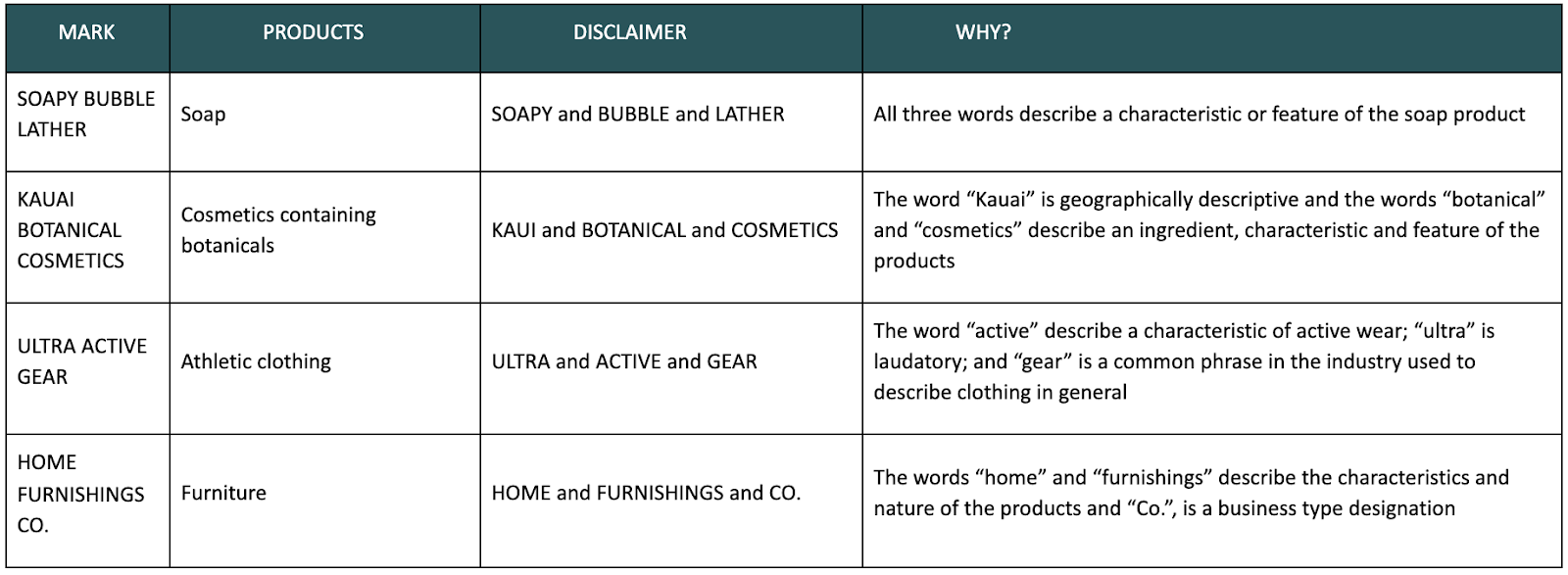
+ FAQ #25: What if there is another mark blocking my application?
As discussed at FAQ #12, there are circumstances where we may suggest you move to oppose or cancel another mark blocking registration of your application. If the blocking mark is still in the application process, we file what is called a “Notice of Opposition.” If the blocking mark has registered, we file what is called a “Petition for Cancellation.” A Notice of Opposition and Petition for Cancellation involve many of the same steps so we refer to them below, generally, as a “Proceeding.”
As discussed at our FAQ #11, we perform Proceeding related services at our hourly rate of $400. Each Proceeding is unique, and its process and outcome are completely dependent on the parties and issues involved. However, below is general description of the process with expected costs and timelines.
Step One – the Demand Letter. In most situations we start with a Demand Letter asking the owner of the blocking mark to voluntarily withdraw its entire application or registration, or, sometimes, specific goods within the application or registration. It generally takes .5 – 1 hour of attorney time to draft and send the Demand Letter. This letter is an informal attempt to resolve the issue without a Proceeding and usually results in one of the following:
- Demand Complied With: Though rare, sometimes the owner of the blocking mark complies with our demand with little or no push-back. In this case, get to skip Step Two (below) and head straight to Step Three.
- Informal Settlement: Sometimes, the owner of the blocking mark will attempt to negotiate an agreement whereby both parties agree to “coexist” in the marketplace, perhaps with a limited scope or use of their respective marks. Whether you should enter into a coexistence agreement depends on the specific facts or your situation. Negotiating a coexistence agreement can take anywhere from 1 hour (simple negotiation) to 3-5 hours (complex negotiation, or many delays by blocking mark) of attorney time. If we secure a coexistence agreement, we will proceed with Step Three (below).
- No response at all: It is somewhat common for the owner of the blocking mark to completely ignore the Demand Letter. If we do not receive a response within a stated time (usually 10 – 14 days) we then proceed to Step Two (below).
Step Two - The Proceeding. We will prepare and file the Proceeding documents at the US Trademark Trial and Appeal Board (TTAB) and the TTAB will serve those documents on the owner of the blocking mark. It generally takes 1 hour of attorney time to prepare and file the Proceeding documents and the TTAB charges a filing fee of $600 per class. The owner of the blocking mark will have 40 days to respond to the Proceeding and we usually expect one of the following responses:
The Owner of the Blocking Mark Answers the Proceeding: If the owner of the blocking mark files a timely answer to the Proceeding, then the Proceeding is “contested.” A contested proceeding operates much like a lawsuit in that both sides have an opportunity to exchange and compile evidence and present their case to “judge” at the TTAB. A contested Proceeding usually ends up in a negotiated coexistence agreement but can, potentially, go all the way to trial. A contested Proceeding can take anywhere from 1 – 5 hours of attorney time (negotiated settlement) to hundreds of hours if the Proceeding goes to trial (rare).
Informal Settlement: Sometimes, in lieu of filing an answer in the Proceeding, the owner of the blocking mark will attempt to negotiate a coexistence agreement, as discussed above in Step One.
No response at all: If the owner of the blocking mark fails to respond to the Proceeding within 40 days, then the TTAB will issue a Notice of Default allowing the owner of the blocking mark to explain why it did not appear in the Proceeding. If the Notice of Default is not responded to, then the TTAB will eventually enter judgment, removing the blocking mark. You can expect about 1 hour of attorney time to review and report the below default judgement notices:
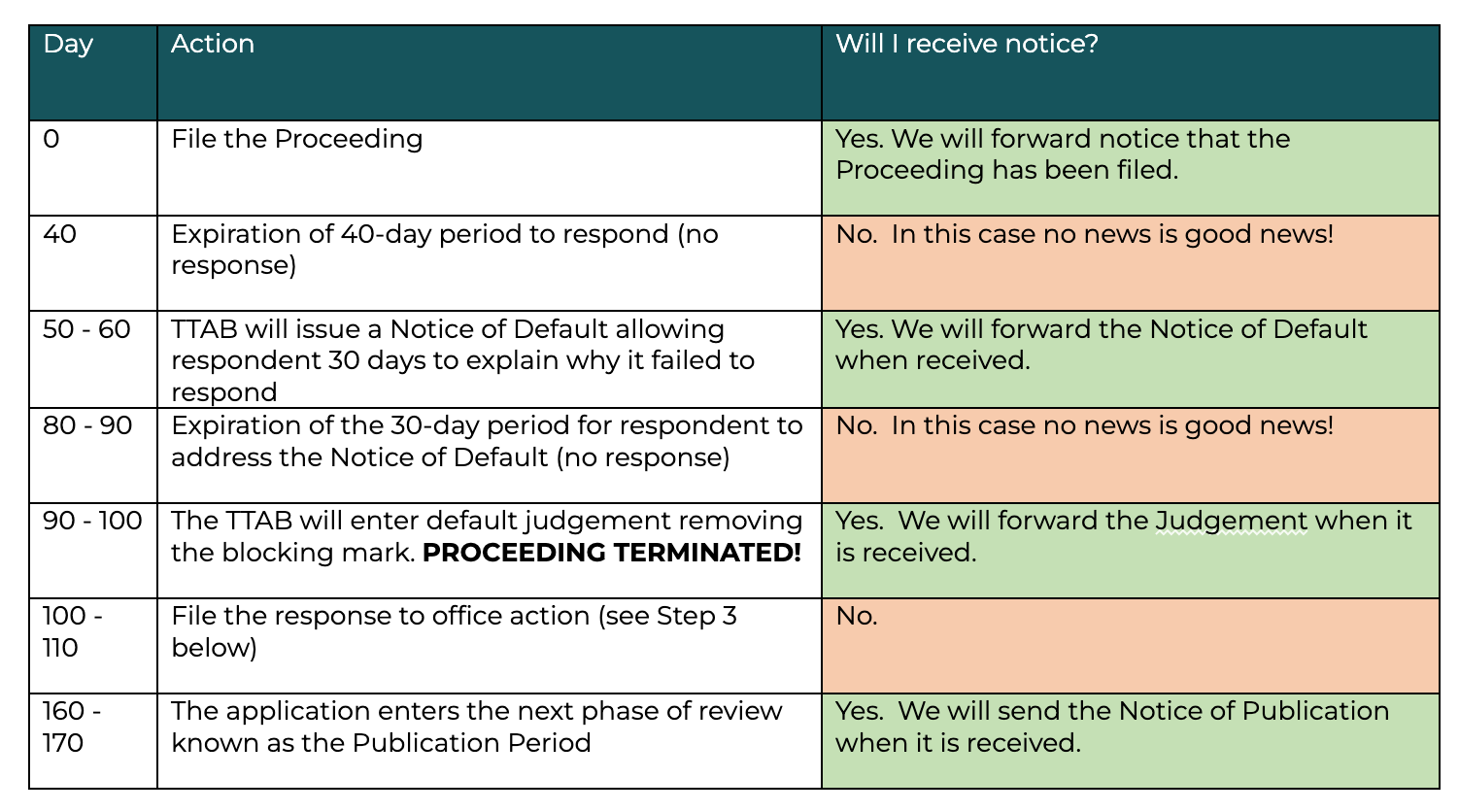
Step Three – Respond to the Office Action. By now you may have forgotten that this Proceeding started because your application received a refusal because of the blocking mark. Now that the blocking mark has been “cleared” either voluntarily, through negotiated settlement, or default judgment, we must respond to the office action informing the examiner that the way is now clear and addressing any other technical issues the examiner may require. Once the examiner reviews and approves the response to office action, the application should proceed to the next phase of review known as the “publication period.” See FAQ #27. It generally takes .5 – 1 hour of attorney time to prepare and file the response to office action.
+ FAQ #26. What is “Likelihood of Confusion”?
One of the main functions of a trademark is to prevent consumer confusion as to the source of the goods or services offered under the mark. For instance, when you see mark NIKE (word mark) or  (design mark) on a shoe, you, as a consumer, should have confidence in knowing that the shoe comes from Nike (i.e. Nike is the source of the show). If a competitor company offers shoes under a mark that is similar to Nike’s marks, then you, as a consumer, might confusingly purchase the shoes from the competitor under the incorrect assumption that is comes from Nike. In such a case, the competitor’s use of a similar mark to sell related goods created confusion as to the source of the goods. This confusion is called Likelihood of Confusion.
(design mark) on a shoe, you, as a consumer, should have confidence in knowing that the shoe comes from Nike (i.e. Nike is the source of the show). If a competitor company offers shoes under a mark that is similar to Nike’s marks, then you, as a consumer, might confusingly purchase the shoes from the competitor under the incorrect assumption that is comes from Nike. In such a case, the competitor’s use of a similar mark to sell related goods created confusion as to the source of the goods. This confusion is called Likelihood of Confusion.
There are several factors used to determine whether two competing marks may cause Likelihood of Confusion, but the two we are most interested in in are the similarity of the marks and the relatedness of the goods sold under the marks.
Similarity of the marks. Marks may be “confusingly similar” if they (i) sound alike when spoken; (ii) are visually similar; (iii) have the same meaning (when translated); or (iv) create the same general commercial impression.
Similarity of the goods or services. If two marks are similar (as discussed above), and the goods or services sold under the respective marks are “related,” then there is Likelihood of Confusion. The goods or services do not need to be identical or even competitive to find Likelihood of Confusion. It is enough that the goods or services are related in some manner or that the conditions surrounding their marketing are such that they are likely to be encountered by the same consumer in a way that might cause confusion. The more similar or related the goods, the less similar the marks can be to find Likelihood of Confusion. Conversely, if the goods or services are not related or marketed in such a way that they would be encountered by the same consumer in a way that might cause confusion, then the marks could be identical and not create Likelihood of Confusion. That is why DELTA exists as a trademark for airline services and for high end faucets – though the marks are identical, the goods and services offered under the marks are not related.
+ FAQ #27. How can I learn the status of my application?
A U.S. trademark application can take anywhere from one year (best case scenario) to several years (worst case scenario) to register. So a good amount of patience will be required while your application makes its way through the review process at the USPTO.
As discussed at our FAQ #11, your flat fee covers certain notices from our office as your trademark application processes (those notices are indicated in blue below). As you can see, you can expect to receive your first notice from our office approximately one year after we file your application. We monitor thousands of trademark applications so, unfortunately, we cannot provide each of our clients with frequent updates or notices beyond those covered by the flat fee. If you would like more frequent “check-ins,” please let us know and we can set you up with monthly reporting billed at our hourly rate of $400.
Otherwise, if you have not yet received one of the below notices from us, it’s because the event has not yet occurred, so please be patient.
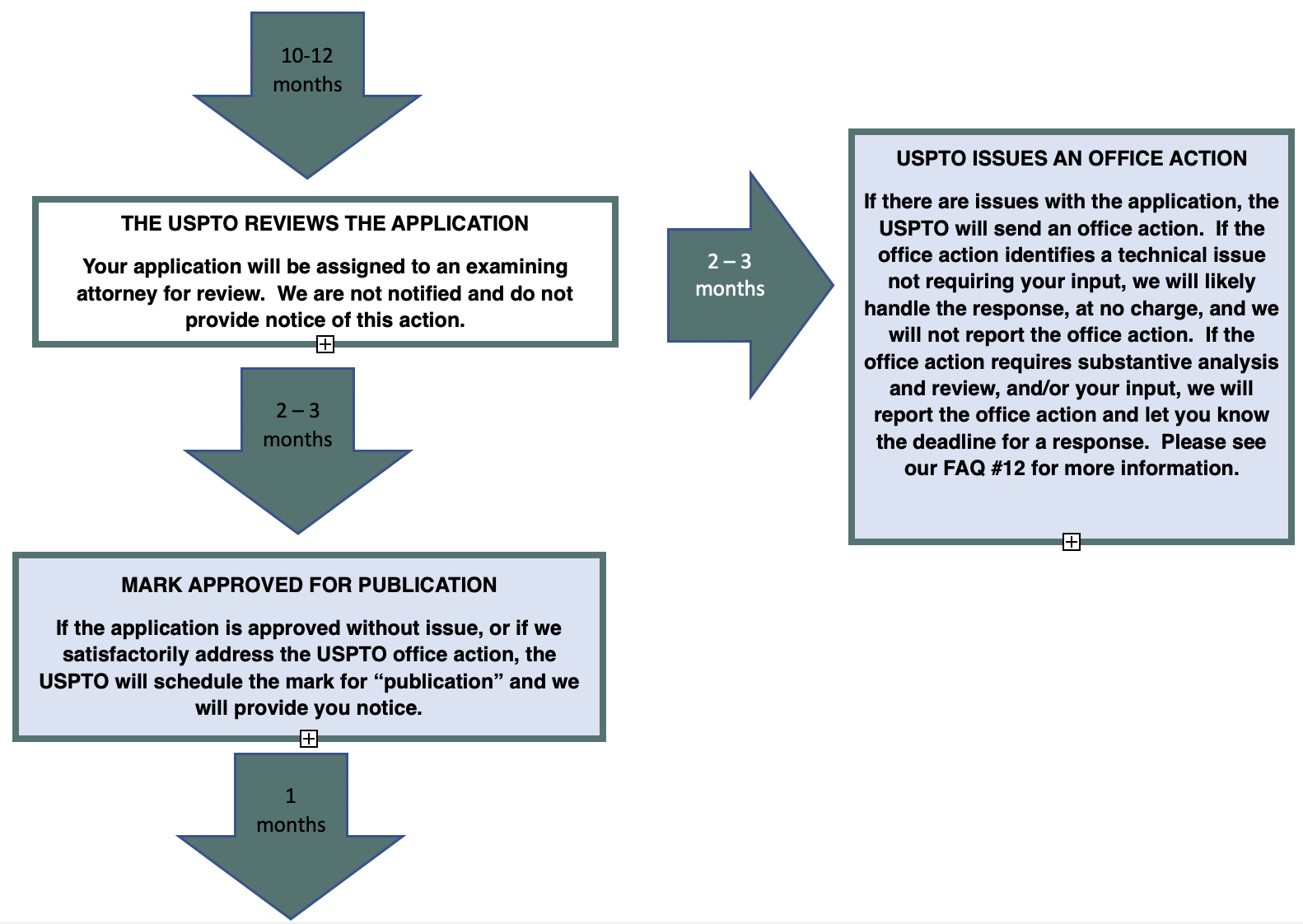
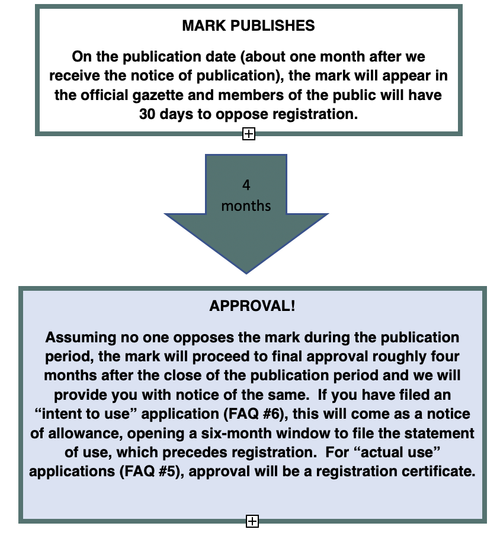
+ FAQ #28. I don’t know what products or services I will sell under my mark yet; can I still apply for a trademark?
The short answer is no.
Trademark rights in the United States extend only as far as the specific goods or services you are selling (or intend to sell) with the mark. For instance, Apple owns trademark rights in phones and computers, but does not have trademark rights in tires or airplanes because Apple does not sell tires or airplanes.
You cannot obtain “general” trademark rights in a mark not tied to specific products. As discussed in FAQ #29, we are not able to file a trademark application that is open-ended as to the goods or services covered. This is because the trademark office examines your application for a likelihood of confusion (FAQ #26) with prior marks based on the set specific goods or services in the application. Instead, you must identify specific products in your application (see FAQ # 30 for information about properly classifying your products). You need to have at least one specific product in mind before we start the application process.
+ FAQ #29. Can my application cover an entire class or category of good?
The short answer is no.
Trademark rights in the United States extend only as far as the specific goods or services you are selling (or intend to sell) with the mark. For instance, Apple owns trademark rights in phones and computers, but does not have trademark rights in tires or airplanes because Apple does not sell tires or airplanes.
You do not obtain trademark rights to an entire category of goods or services by virtue of the fact you sell one or some products within the category. For instance, if you use your brand to sell hair brushes, we would apply to register your mark for hair brushes (a specific product) and not “health and beauty” (a category) because “health and beauty” could cover thousands of different products, spanning several International Classes, that you do not sell (i.e. cosmetics in Class 3, supplements in Class 5, massagers in Class 10, or hair wraps in Class 25). Please see FAQ #30 for information about properly classifying your specific products.
Similarly, you cannot obtain trademark rights to an entire Class by virtue of the fact you sell one product or service within the same Class. For example, if your brand sells hair brushes (Class 21), you do not then obtain trademark rights to all Class 21 products which include things like spatulas, baskets, vases, and coasters.
Note, however, that if your competitor is using a similar mark to sell “related” goods or services, you may be able to enforce your trademark registration to prevent the sale of those goods even if they are not specifically described in your registration. See FAQ #26 (“Similarity of the goods or services”) for more information about related goods/services and likelihood of confusion
+ FAQ #30. How do I determine which products or services to include in my trademark application?
Many times, figuring out which products or services to include in your application (or not) is the hardest part of the trademark application process, but we can determine the best way forward using a two-step analysis. First, working together, we will determine the proper classification for your products or services. Second, you will then weigh application costs vs. benefits, given your personal business needs, to determine which products or services to include in the application. Each step is discussed below.
Step One – Determining Product or Service Classification
The USPTO follows the “Nice Classification System” that classifies goods and services among 45 “International Classes.” When we talk about a “Class” we are referring to one of the 45 International Classes under the Nice Classification System.
In our questionnaire, we ask you to specifically identify the products or services you are selling (or intend to sell) under you brand. This is an important step of the application process because it allows us to properly classify your products or services. We ask that you specifically identify your products because trademark rights in the United States extend only as far as the specific goods or services you are selling (or intend to sell) with the mark. For instance, Apple owns trademark rights in phones and computers, but does not have trademark rights in tires or airplanes because Apple does not sell tires or airplanes.
By using the UPSTO identification manual (http://idm-tmng.uspto.gov/id-master-list-public.html) , as well as our professional experience and judgment, and based on your questionnaire responses, we will advise on the appropriate Classes for your specific products and/or services, which then determines the cost of your application (Please see our FAQ #10 for fees). Let’s use some examples:
Amir: In response to the questionnaire, Amir identifies the products sold under his brand as “health and beauty products.” “Health and beauty products” is not an acceptable identification because it could cover thousands of different products spanning several Classes (i.e. cosmetics in Class 3, supplements in class 5, massagers in Class 10, or hair wraps in class 25). The USPTO would issue an office action response requiring Amir to clarify his goods description, which would cause delay and additional expense. In this case, we would direct Amir to this FAQ and ask him to follow up with specific product identifications before we can provide guidance on classifications or fees.
Maria: In response to the questionnaire, Maria identifies the products sold under her brand as: bath toys, shampoo, washcloths, towels, bathrobes, bar soap, pet brushes, pet shampoo, hair brushes. Using the UPSTO identification manual (http://idm-tmng.uspto.gov/id-master-list-public.html) , as well as our professional experience and judgment, we are able to advise Maria that her products belong in the following Classes:
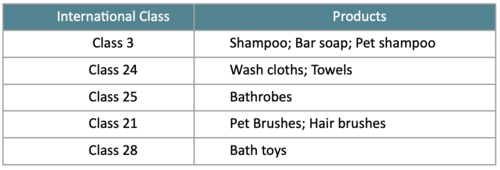
Now that we have properly classified Maria’s products, Maria must determine which products she would like to include in the application in Step 2.
Step 2 – Determining Which Products or Services to Include in the Application
The number of Classes claimed in the application determines the cost of the application: the more Classes, the higher the cost (see FAQ #10 for pricing information by Class). But the products or services identified in your application also determine the scope of your registered trademark rights: the more registered products or services, the broader your rights. So you must weigh cost against stronger trademark rights, as shown below.
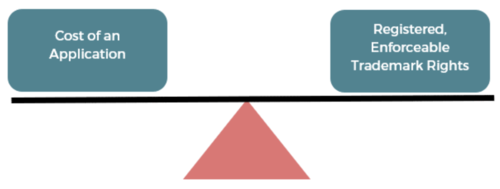
Your application may include as many (or few) products as you wish. Having broader rights makes your trademark easier to enforce against competitors:
Having registered trademark rights in a specific product or service makes a “cease and desist” demand more forceful, and makes you better able to get third party retail sites (like eBay, Amazon, Etsy) to remove the listings of potentially infringing sellers. For instance, if your brand is used to sell shampoo (Class 3), bathrobes (Class 25), and towels (Class 24), and you decide to include only the shampoo product in your application, if someone later sells towels under a mark that is the same or highly similar to your mark, it will be harder to enforce your brand against the other seller since you do not have registered trademark rights for towels.
Having registered trademark rights in one product or service should prevent another company from obtaining a trademark registration for a similar mark for the same or “related” products, as this would cause “likelihood of confusion” (see FAQ #26 regarding likelihood of confusion). What is or is not a “related” product or service is a somewhat subjective judgement call for an examining attorney to make. For instance, if your brand is used to sell shampoo (Class 3), bathrobes (Class 25), and towels (Class 24), and you decide to include only the shampoo product in your application, you will have registered trademark rights in shampoo only. If someone later applies for the same mark for bathrobes, and the trademark office determines bathrobes are not “related” to shampoo, the trademark office will allow registration of the other party’s mark for bathrobes. If your application had originally included bathrobes, the after-filed application would have been refused registration.
With the above in mind, you must make a business decision that is personal to you and your business, weighing costs and benefits, about how many classes to include in your application.
+ FAQ #31. Once my trademark registers, how do I renew the registration?
A window for renewing your registration with the USPTO opens between the 5th and 6th anniversary of your trademark registration date. To renew the registration, we will submit evidence (a “specimen,” FAQ #8) to the USPTO showing that you are still using the mark for the goods identified in the registration.
Subsequent renewal windows open every ten years.
When these renewal windows open, we will send you an email with your renewal options and costs. There is no charge for keeping track of and notifying you of the renewal deadlines. Please make sure to let us know if your email contact information changes, so we can update our records and let you know about these deadlines.
At this time, the fees for maintenance filing services are as follows:

Finished With the FAQ? Time For the Next Step!
Whether you’re ready to work with us or you just want more information, the first step is to get in touch with us. Tap the button below and tell us about yourself.
We’ll follow up within one business day to kickstart the U.S. trademark application process..



